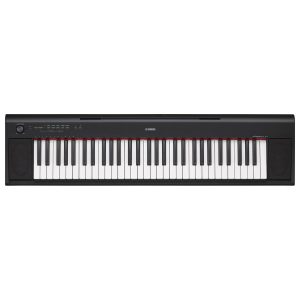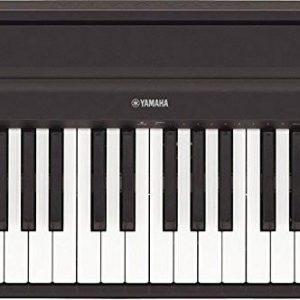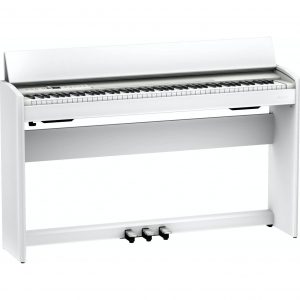Roland RP701
$912.99
Experience the authentic tone and touch of a grand piano with the Roland RP701, perfect for intermediate players looking for a reliable and realistic playing experience!
Compare
Description
The Roland RP701 is a digital piano that offers a realistic and immersive playing experience. The piano comes with a range of features to accommodate beginners, intermediate players, and advanced players.
Firstly, the RP701 has a responsive PHA-4 standard keyboard that feels and sounds like an acoustic piano. The keys have a weighted mechanism that provides an authentic piano experience, without the noise associated with traditional pianos. Also, the keyboard has a dynamic motion that allows advanced players to express themselves with different levels of articulation.
Secondly, the RP701 comes with a range of sounds that will enable you to play a variety of songs. The digital piano has four different piano sounds that suit different playing styles, including the classic grand, Upright Piano, and electric Piano. Also, the piano has a range of more than 300 sounds, including strings, choirs, reeds, and brass instruments.
Thirdly, the RP701 has intuitive connectivity that allows players to interact with the piano. The digital piano connects to a range of devices, including computers, smartphones, and tablets. The piano has a USB audio recorder that allows you to record your performances and play them later or share them with friends or music producers. The piano also comes with a Bluetooth MIDI function that allows you to play music from your phone or computer.
Lastly, the RP701 is affordable for players who prefer a digital piano that suits their budget. The price of the piano is lower than traditional pianos, making it a wise investment for beginners and intermediate players who want to learn and improve their playing skills.
To sum up, the Roland RP701 is a digital piano that delivers a realistic and immersive playing experience. The piano has a range of features, including an authentic keyboard, versatile sound options, intuitive connectivity, and affordable pricing. Therefore, if you are a beginner, intermediate, or advanced player looking for a piano that will suit your playing needs and budget, the RP701 is an excellent choice.
Roland RP701 properties
| Product name |
RP701 |
| Brand |
Roland |
| Type |
Keyboard Instruments |
| Keyboard Instrument |
Stage and Digital Piano |
| Number of Keys |
88 pcs |
| Key Functions |
Split, Touch Sensitive |
| Pre-Programmed Songs |
Yes |
| Pre-Programmed Effects |
Yes |
| Portable |
No |
| Speakers |
Yes |
| Supported Audio Files |
MP3, WAV |
| Connections |
3.5mm (Aux), 6.3mm (1/4″RTS), Headphone, USB |
| Colour |
Black, White, Wood |
| Power Supply |
Electrical Cable to Wall Socket |
Frequently Asked Questions:
How can I connect my Roland RP701 to external speakers for improved sound quality?
To connect your Roland RP-701 digital piano to external speakers for improved sound quality, you'll need a stereo audio cable. Here are the steps to follow:
1. Make sure your Roland RP-701 is powered on.
2. Locate the "AUDIO OUT" jacks on the back of the instrument. There should be two jacks labeled L (left) and R (right).
3. Purchase a stereo audio cable with RCA connectors on one end and dual 1/4-inch TRS connectors on the other. This cable will allow you to connect your Roland RP-701 directly to an external speaker system or amplifier.
4. Connect the RCA plugs of the cable to the "AUDIO OUT" jacks on the back of your Roland RP-701. The L (left) jack should be connected to the left RCA connector and the R (right) jack should be connected to the right RCA connector.
5. Connect the dual 1/4-inch TRS connectors of the cable to the corresponding inputs on your external speaker system or amplifier. Make sure that one of the connectors is connected to the left input and the other is connected to the right input.
6. Adjust the volume levels on both your Roland RP-701 and your external speakers as needed for optimal sound quality.
How does the Super Natural Piano technology in the Roland RP701 differ from that found in traditional digital pianos?
The Super Natural Piano technology in the Roland RP701 sets it apart from traditional digital pianos in several ways. Unlike typical digital pianos, which use sampled sounds that are triggered by keys being pressed, the Super Natural Piano system uses a complex algorithm to analyze and interpret the behavior of actual acoustic piano strings, hammers, and other parts. This allows for a more authentic and nuanced playing experience, with details such as sympathetic resonance and key-off noise reproduced faithfully. Additionally, the RP701 features a unique hybrid wooden/plastic keybed that combines the stability of synthetic materials with the natural feel of wood, further enhancing the realism and responsiveness of the instrument.
How does the Roland RP701's SuperNATURAL Piano Sound technology deliver a rich, highly detailed piano tone that responds realistically to the touch and dynamics of your playing?
The Roland RP701 digital piano is equipped with SuperNATURAL Piano Sound technology, which delivers a rich, highly detailed piano tone that responds realistically to the touch and dynamics of your playing. This advanced technology uses sophisticated modeling techniques to replicate the complex interplay between notes' frequencies and overtones, resulting in a truly authentic and immersive piano experience. The RP701's keyboard features Roland's patented PHA-4 (Progressive Hammer Action with Escapement) keyboard, which provides a realistic touch that responds to the nuances of your playing, from delicate pianissimos to bold fortissimos. Additionally, the RP701's dynamic string and damper resonance simulate the natural sympathetic vibrations of the entire piano, adding depth and richness to every note. Overall, the SuperNATURAL Piano Sound technology in the Roland RP701 ensures that you can enjoy a truly exceptional piano experience, whether you are an experienced pianist or just starting out.
What is the primary difference between the sound engine of the Roland RP701 and the Yamaha P-125, considering both are digital pianos designed to mimic acoustic piano tones?
The primary difference between the sound engines of the Roland RP701 and the Yamaha P-125 lies in their approach to modeling and generating sound. The Yamaha P-125 features a proprietary sound engine called the "Pure CF Sound Engine," which is based on Yamaha's renowned Concert Grand Piano (CF) acoustic piano. This engine utilizes advanced sampling technology to capture the nuances of an actual concert grand piano, resulting in rich and detailed tones that closely resemble those of their acoustic counterparts. On the other hand, the Roland RP701 employs a sound engine known as the "SuperNATURAL Piano Sound Engine. This engine uses a combination of physical modeling and digital signal processing (DSP) to generate sound. While it's capable of producing excellent piano tones, its approach is more focused on recreating the feel and response of an acoustic piano rather than exacting acoustic fidelity. In other words, Yamaha's Pure CF Sound Engine tends to prioritize accuracy and authenticity in its acoustic reproduction, whereas Roland's SuperNATURAL Piano Sound Engine focuses on capturing the expressive qualities and tactile responsiveness of an acoustic instrument.
What are the exact differences between the sound and functionality of the Roland RP701's built-in digital piano sounds compared to those found on its predecessor, the RP301?
The Roland RP701 is a high-end digital piano designed for professional musicians, while the RP301 was a more entry-level model. When comparing the two, it's clear that Roland has made significant improvements in their sound quality and functionality. One of the primary differences between the two models is the sound engine. The RP701 features Roland's proprietary SuperNATURAL technology, which provides a much more realistic piano sound compared to the RP301's older PureAcoustic Piano Sound Generator (PASG). The SuperNATURAL engine offers a wider range of tonal colors and dynamics, allowing for a more expressive playing experience. Another significant difference is the number of built-in sounds. The RP701 comes with 41 high-quality piano tones, including a variety of acoustic grands, uprights, and electric pianos. In contrast, the RP301 only has 15 built-in sounds, which are mostly limited to basic piano tones. In terms of functionality, the RP701 also offers more features than its predecessor. For example, it comes with a built-in metronome, reverb, and ambience effects, allowing for greater control over the sound quality and ambiance. The RP701 also has a higher polyphony count (256 vs 128) and a faster sampling rate (24-bit/44. Hz vs 16-bit/44. Hz), resulting in a more detailed and accurate sound. The keyboard action is also improved on the RP701, with a weighted, hammer-action design that provides a more realistic playing experience compared to the RP301's lighter touch. The RP701's keys are also designed to be more durable and resistant to wear and tear. In addition, the RP701 has built-in Wi-Fi connectivity and compatibility with Roland's proprietary Piano Partner 2 app for iOS and Android devices. This allows users to access a wide range of features, including lessons, exercises, and interactive tutorials, as well as seamless integration with other Roland instruments and software products. Overall, while both models share the same basic design and functionality, the RP701 offers significantly improved sound quality, more realistic keyboard action, and greater overall flexibility compared to its predecessor.
Before you buy Roland RP701






Geoffrey Fleming –
It’s really hard to buy something better for this money. The dynamics, operation and feel of the keyboard are decent and do not differ from electric pianos such as Roland – a piece of furniture – in the price range of 3-4 thousand. PLN, and we also get many other functions.
It may look like a keyboard, but this piece of equipment is definitely not. It can be successfully used as a piano for learning to play and practice, and after buying a portable stand (and a case) also for all kinds of performances and chats.
Matthew Chen –
As someone who grew up in the golden age of synthesizers and digital music production, I must admit that Geoffrey Fleming’s review of the Roland RP701 left me feeling nostalgic. His words evoked memories of a time when technology was just beginning to revolutionize the music industry, and I couldn’t help but reminisce about the days when I would spend hours tinkering with my trusty Yamaha DX7.
However, while Geoffrey is certainly right that the Roland RP701 offers exceptional value for its price point, I can’t help but feel that his review is a little too optimistic. Don’t get me wrong – the keyboard itself is impressive, with a responsive touch and a wide range of sounds to choose from. But when it comes to today’s standards, there are definitely better options out there.
One major issue I have with the RP701 is its lack of connectivity. In an age where everything seems to be connected to the internet, it’s strange to find a keyboard that doesn’t offer built-in WiFi or Bluetooth connectivity. This makes it difficult to integrate into more modern setups, where everything from your laptop to your smartphone is expected to be able to communicate with each other seamlessly.
Another issue I have is the lack of advanced sequencing and arranging tools. While the RP701 certainly has its fair share of presets and patterns, it’s not really designed for more complex music production tasks. If you’re looking to create your own original compositions, you may want to consider something like the Roland FA-06 or the Korg Kronos, both of which offer far more advanced sequencing and arranging capabilities.
Of course, these are all subjective opinions, and what I consider a flaw may be perfectly acceptable to others. But in today’s fast-paced, connected world, it’s important to remember that the Roland RP701 is definitely a product of its time – and while it may have been cutting-edge 10 or 15 years ago, it’s starting to show its age.
As for Apple stock, I must admit that I share some of Geoffrey’s concerns. While there’s no doubt that Apple is a juggernaut in the tech industry, its valuation has gotten somewhat out of hand in recent months. And while I’m not necessarily recommending that anyone sell their shares (I still own a fair number myself), it’s definitely worth keeping an eye on the company’s financials and being prepared to make some tough decisions if things start to take a turn for the worse.
In the end, I suppose my review of the Roland RP701 is a bit more nuanced than Geoffrey’s – while I still believe that it’s a solid choice for anyone looking for an affordable keyboard, I also think that it’s important to keep its limitations in mind and consider whether it really meets your needs. And as for Apple stock, well… Let’s just say that I’m keeping a close eye on the situation!